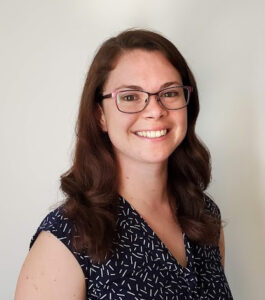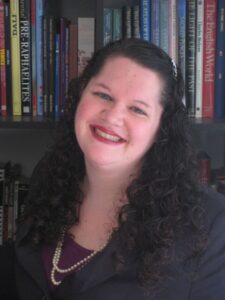
After completing my doctorate, I searched for over a year for a teaching role in the United States—however, finding a place where I could teach Christian systematic theology, as a woman and a mutualist, was no small feat.[1] Schools that might hire me because of doctrinal alignment often had statements of belief that ruled out my teaching either because of being a woman or because I wouldn’t hold to a hierarchical understanding of men’s and women’s roles. Schools that might hire me despite, or even because of, being a woman, were often not a good fit doctrinally. I’ve always had a love for the local church and wanted to do theology from a confessional positionality and to equip students within Christian theology. Add to that the general lack of jobs in higher education, especially within the humanities, and even more so in theology, and my search necessarily became global.
While these reasons were more negative for my enlarged search, there was also a positive pull to a specific school in Aotearoa New Zealand. There, I found a small Baptist college that was (and is) committed to supporting women in theology and in the local church. We discerned strong alignment in my interview process, and I remember sensing that there was just as much that I could learn from this community as I could possibly hope to teach. So, at the beginning of 2020, my family and I moved to Auckland so that I could teach systematic theology at Carey Baptist College.
Since that time, I have been deeply impacted by my time here. I have been exposed to different value systems and worldviews. From my Māori (the indigenous people of Aotearoa New Zealand) friends, students, and colleagues, I have learned the importance of knowing and acknowledging the people from whom you come.[2] For instance, while I was used to weighing out a publication output based on what it would add to my CV, my friends here think of it in terms of how it will honour their community and their grandparents, and create a better world for their grandchildren (potential though they may be). I didn’t realise how much these values had affected me until my recent trip back to the United States for conferences in Denver and to see my family in Georgia.
Much to the dismay of many of my academic friends whom I met up with at the American Academy of Religion (AAR) meeting, the first conference I attended was the Evangelical Theological Society (ETS) meeting. I believe the dismay is for a few reasons. First, the highly conservative nature of some members of this community—what I would call “culturally evangelical”—tend to subordinate women to men, are blind to systemic injustice, are uncritical (and unaware) of power imbalances, and are funding the “Conservative Resurgence” as a cultural war against liberal agendas.[3] To my friends and concerned colleagues, this is unsalvageable. However, my solace is that the society is not predominantly evangelical in a cultural sense. Instead, they are evangelical in the sense of foregrounding (making primary) the good news, “gospel”—the euangelion—which is where “evangelical” comes from. Such a form of evangelicalism is definitely shaped by culture and wants to be a positive influence within culture, but it is not seeking to save culture.
So, while ETS has “Evangelical” in the very title, this is a term appropriated differently by individual members. However, my friends might still balk, especially when they see that members must affirm inerrancy (and the Trinity, but that causes less of a reaction). Yet, even on inerrancy I’ve found the term understood more and less rigidly among ETS’s members. Personally, I’ve found Mike Bird’s article on inerrancy to be quite helpful given the culture wars around this concept, and to help Americans zoom out from our parochial mindsets. Looking at a brief history of this concept, he notes “while many American evangelicals preached the inerrancy of the text, what they often practiced was the inerrancy of their interpretation and the hegemony of their tribe in certain denominations.” Again, within ETS there are those who wield inerrancy as a weapon (the Bible says it so we can take a “plain reading” of the text without an interpretation) and those who believe that God has not erred in communicating what God wants to communicate through Scripture (our methods and communities of interpretation are important, while not undermining inspiration). So, my conversations with AAR friends after the ETS conference were ongoing defences of this society—that there is still a lot of good happening in this space: scholarship that foregrounds the gospel as the good news that it is.
I was privileged to hear this scholarship on: a feminist reading of Luke’s parable of the persistent widow (along with the recognition that there are feminisms and that these are often misunderstood in Christian theology); an exposition of Mary’s song as prophetic discourse and its relation to women’s full inclusion in ministry roles; a response paper enlisting Willie Jennings and Edward Said to critique the empire building of American Evangelicals; and a dogmatic ecclesiology that understands sacraments as important ordinances but in a way that de-centres church polities which exclude women from administering them, to name but a few. As a society, ETS has influence far beyond its annual meeting, and these papers gave me hope for ways that evangelicalism, especially in America, might again be a movement about the good news of Jesus Christ.
At the same time, this is not a blind hope, especially for women and ethnic minorities who are still in this society. This remains a very challenging space to exist in, let alone, to be active in.
To illustrate, the first session of papers that I went to (the second paper up was a friend of mine, whom I wanted to support) was given by a former professor of mine. I had run into him the night before at registration and re-introduced myself in case he’d forgotten my name. He commented, “you’ve come a long way to be here.” I was initially struck by this since, at his first glance around the room, he didn’t seem to recognise me, but then his comment indicated that he remembered me and knew that I was not geographically nearby. While not wanting to read too much into his comment, my sense that it was odd that he did know who I was and where I had come from made more sense as I sat in that first session. Most of his essay’s content was critiquing a chapter I had recently written in a book defending men and women’s equality.[4] Unfortunately, he did not characterise my argument accurately or charitably and explained my theology of the body as the opposite of what I argued.
Fortunately, after each paper there is time for interaction, and I couldn’t raise my hand fast enough. He called on me, and as I stood, he explained to the standing-room only audience that “this is the Christa from the paper.” I then had a chance to find our points of commonality (and there was one!) and briefly our points of difference—primarily how he had misunderstood and mischaracterised my chapter. While he didn’t address my concerns I raised or the objections in the chapter itself, I had a chance to clarify for the audience where our disagreements actually lay. This is what academic discussion is meant to do: to provide a place for us to have read and listened carefully and charitably to others so we can engage each other’s strongest arguments and make them better or find them too lacking and change our own views. Scholarly communities are thus critical for our thinking to grow. However, if we provide a strawman (or strawwoman, in my case) of a person’s argument, this undermines the effectiveness of the scholarly community. Further, when essays are used to undermine scholar’s credibility by misrepresenting their arguments, this is a misuse of power and needs to be held to account.
I don’t think this former professor wanted me in that room. If he had, he could have easily invited me to the paper the night before when he saw me. He could have emailed me the paper before the conference to make sure he’d understood me correctly. As my brother in Christ, he could have treated me with the dignity of his sister.
But what surprised me was my takeaway from that experience.
I realised: These are my people.
I’m the granddaughter of a Southern Baptist Reverend. The daughter of a Southern Baptist Minister. I grew up Southern Baptist, and those roots have given me a love for the Bible and Jesus, even if this is also enmeshed with cultural evangelicalism. While I have distanced myself from Southern Baptists, I am still Baptist through and through. And one of the best ways I can serve my people is to show up, think well, work hard, speak out, and also write about these experiences.
I do wish this had been my only negative experience. Unfortunately, there was also a business meeting wherein an amendment to a bylaw regarding the roles of members of the executive committee of ETS was introduced that would change all instances of “he” to “he or she,” and I (along with others) had to argue for this amendment to pass. I was called “overly sensitive” and a “product of wokeness” for arguing in favour of this amendment. Fortunately, only 11 people voted against the amendment out of a business meeting of roughly 120 voting members. Such a vote revealed not only the vocal nature of the group that opposed the amendment, but also their minority status in the broader society (and how few voting members attend these meetings!). Separately, women recounted being asked whose wife they were, not being looked in the eyes, or being called “girls.” In terms of ideology, one presenter compared egalitarianism to ebola and the way it is killing the church. Such experiences affect women differently from men, which is why we need more men to be advocates in these spaces.
However, I am in a position of privilege that affords me the mental, emotional, spiritual, and physical stamina to be in these places. I have an institution that supports me wholeheartedly. I have a partner who believes in me and will do whatever it takes for me to be in these spaces. I do not depend on the men in this society for my career’s success.
This is the place I am meant to be.
So, my reasons for staying at ETS are that there is hope that more scholarship that foregrounds Jesus will be researched and published, but also, in order to be in the room when arguments, positions, and people are being belittled. Of course, I do long for ETS to be a safe place for women, ethnic minorities, and frankly, anyone who wants to foreground Jesus in their scholarship. In my opinion, for now, choosing to be in this place, especially for these more vulnerable communities, is a matter of conviction and calling. Conversely, for those ETS members or affiliates who are not in these vulnerable communities, I do believe there is a responsibility to be in this place to advocate for change and ensure that ETS is the kind of scholarly community that causes growth instead of harm.
For my part, I am grateful to have a renewed understanding and sense of love for and calling to this people and this place, and I look forward with tempered hope for what is to come.
[1] I prefer the term mutualist to egalitarian given the baggage associated with egalitarianism and its focus on men and women having equal authority. Since I don’t believe that fellow Christians are meant to have authority over one another, I use mutualism to discuss the mutual submission of men and women to one another as this is the emphasis I see in the New Testament model of the church as siblings. Also, I recognise that being on the job market for only a year is remarkable.
[2] This would also include your land. As this is a journey I am very much still on, I don’t know enough about my ancestors to know all the lands from which we came, but enough to know that most of my ancestors were not indigenous to Turtle Island (North America).
[3] For a fascinating ethnographic sociology of the “Conservative Resurgence,” I would recommend Lisa Weaver Swartz, Stained Glass Ceilings: How Evangelicals do Gender and Practice Power, New Jersey: Rutgers University Press, 2022.
[4] “Imago Dei and Divine Presence: A Critique of Gender Essentialism,” in Discovering Biblical Equality. Revised and Expanded edition, edited by Ronald Pierce, Cynthia Westfall, and Christa L. McKirland. Downers Grove, IL: InterVarsity Press, 2021.

Christa L. McKirland is a lecturer in Systematic Theology at Carey Baptist College in Aotearoa New Zealand. She is also the Executive Director of Logia International. She loves working on theological anthropology and learning about this sub-discipline from her two children: Raya, six and Johnny, four.










